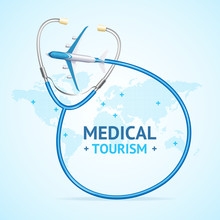Medical tourism – traveling to another country for medical care
Centers for Disease Control and Prevention (CDC)
Traveling to another country to get medical care can be risky. Below, you will learn about the risks and how to minimize them.
Traveling Internationally for Medical Care
Each year, millions of US residents travel to other countries for medical care, which is called medical tourism. Medical tourists from the United States most commonly travel to Mexico and Canada, and to several other countries in Central America, South America, and the Caribbean.
The reasons people may seek medical care in another country include:
• Cost: To get a treatment or procedure that may be cheaper in another country.
• Culture: To receive care from a clinician who shares the traveler’s culture and language.
• Unavailable or unapproved procedures: To get a procedure or therapy that is not available or approved in the United States.
The most common procedures that people undergo on medical tourism trips include dental care, cosmetic surgery, fertility treatments, organ and tissue transplantation, and cancer treatment.
Medical Tourism Can Be Risky
The risk of complications depends on the destination, the facility where the procedure is being performed, and whether the traveler is in good health for the procedure or procedures.
Other issues that can increase a traveler’s risk of complications include:
• Infectious Diseases.
All medical procedures have some risk of infection. Complications from procedures performed in other countries include wound infections, bloodstream infections, donor-derived infections (in the case of transplantations or transfusions), and diseases such as hepatitis B, hepatitis C, and HIV.
• Antimicrobial resistance.
Highly drug-resistant bacteria and fungi have caused disease outbreaks among medical tourists. Antimicrobial resistance happens when germs develop the ability to not respond to drugs such as antibiotics used to treat infections. Antimicrobial resistance is a global problem. Healthcare facilities in another country may not have adequate infection control practices and medical tourists could be at risk for getting a drug-resistant infection.
• Quality of Care.
Some countries’ requirements for maintaining licensure, credentialing, and accreditation may also be less than what would be required in the United States. In some countries, counterfeit medicines and lower quality medical devices may be used.
• Communication challenges.
Communicating with staff at the destination and healthcare facility may be challenging. Receiving care at a facility where you do not speak the language fluently could lead to misunderstandings about your care.
• Air Travel.
Flying after surgery can increase the risk for blood clots, including deep vein thrombosis. Delaying air travel for 10-14 days following major surgeries, particularly those involving the chest, will minimize risks associated with changes in atmospheric pressure.
• Continuity of Care.
Travelers may need to get health care in the United States if they develop complications after returning. Follow-up care for complications might be expensive. Treatment might be prolonged and might not be covered by your health insurance.
How You Can Minimize Medical Tourism Risks
Research the clinician and facility
Check the qualifications of the clinician who will be doing the procedure and the credentials of the facility where the procedure will be done. Accrediting groups, including Joint Commission International, DNV GL International Accreditation for Hospitals, and the International Society for Quality in Healthcare, have lists of standards that healthcare facilities need to meet to be accredited. Please note that all surgeries carry the risk of complications and accreditation does not guarantee a positive outcome.
If you go to a country where you do not speak the language, determine ahead of time how you will communicate with your clinician and others who will be caring for you.
Before you travel
• Get a pretravel consultation. See your healthcare provider or a travel medicine clinician at least 4–6 weeks before the trip to discuss general information for healthy travel and learn about specific risks you may face because of your health status, the procedure, and travel before and after the procedure.
• Obtain international travel health insurance that covers medical evacuation back to the United States.
Find out what activities are not recommended around the time of the medical procedure, such as swimming or hiking, and plan accordingly.
• Maintain your health and medical records. Bring copies of your medical records with you, including results of lab tests and other tests related to your condition and care. Inform the medical staff at your destination of allergies you may have.
• Pack a travel health kit with your prescription and over-the-counter medicines in their original packaging. Bring enough medicine to last your whole trip, plus a little extra in case of delays. Also, bring copies of all your prescriptions and a list of medications you take, including their brand names, generic names, manufacturers, and dosages.
• Get copies of all your medical records from the medical facility at your destination before you return home. You may need to get them translated into English.
• Arrange for follow-up care before you travel. Identify where you will be staying immediately after the procedure. Make sure you can get any needed follow-up care in the United States. Follow-up care for medical complications can be expensive and might not be covered by your health insurance. Travelers considering procedures outside the United States should understand the potential financial costs associated with follow-up care or emergency care in the event of complications, review their health insurance policies to determine what, if anything, is covered and plan for the possibility of paying for additional care out-of-pocket.
• Supplemental travel health insurance may also be available to cover follow-up or emergency care from procedures received abroad.
